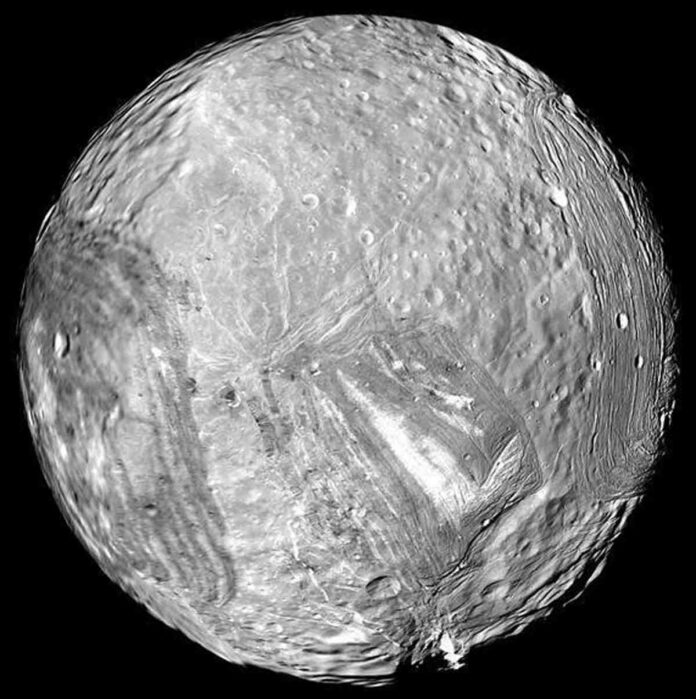A pair of researchers led by The Carl Sagan Center at the SETI Institute in California investigated the potential origin of the thick regolith deposits on Uranus’ moon, Miranda. The study was published in The Planetary Science Journal. The goal of this research was to determine Miranda’s internal structure and particularly its interior heat. This can help determining whether Miranda has or has ever had, an internal ocean.
Regolith is defined as “a region of loose unconsolidated rock and dust that sits atop a layer of bedrock,” and the surface material on the moon and Mars is frequently referred to as regolith rather than soil. The distinction is that soil provides necessary nutrients and minerals for growth, whereas regolith is considered dead soil.
“Miranda is small in size. So, it is unlikely that it could retain a subsurface ocean to the present day,” said Dr. Chloe Beddingfield, a scientist at NASA Ames Research Center. “A thick regolith layer, on the other hand, would act as an insulator. It can trap heat inside Miranda and extending the life of a subsurface ocean for some time. This trapped heat would have also favoured longer-term endogenic activity on Miranda. This activities would include the geologic activity that formed one or more of Miranda’s coronae or the global rift system.”
The researchers used craters, specifically “muted” craters, to determine the thickness of Miranda’s surface regolith for the study. These analyses included calculating crater depth-diameter ratios, crater size-frequency distributions (also known as “crater counting”) and the central mound within Alonso Crater. The study’s findings identified three potential sources for Miranda’s thick regolith. These are giant impact ejecta, plume deposits and Uranian ring deposits. Miranda’s blue colour and its large spatial extent and thickness, lead the researchers to favour the ring deposit hypothesis.
Miranda was discovered on February 16, 1948, at the McDonald Observatory in western Texas by Gerard P. Kuiper. It was only visited by NASA’s Voyager 2 spacecraft in 1986. This close encounter revealed a chaotic and intriguing world with craters, valleys, and chasms across its surface. But scientists still debate about the processes underlying the small moon’s intriguing features to this day. One type of feature is known as “coronae.” These are large deformations formed by tectonic activity, according to scientists. So, how can this research assist us in better understanding Miranda’s overall appearance?
“Miranda’s thick insulating regolith would reduce heat loss and possibly enhance geologic activity. So, the regolith may have assisted in coronae formation,” Dr. Beddingfield explained. “The coronae are thought to have formed as a result of upwelling diapirs that broke the surface of Miranda. Perhaps the coronae got their polygonal shapes from diapirs that formed along pre-existing areas of weakness in the lithosphere. It was caused by pre-existing faults that make up the global rift system. Miranda’s regolith does not reveal much about the specific processes involved in corona formation. But it does allow us to get a sense of the relative timing of events and demonstrates that geologic activity likely occurred over long periods of time.”
The paper emphasises that additional research is needed to better understand Miranda’s thick regolith’s potential sources other than Uranus ring deposits.
Currently, Voyager 2 is the only spacecraft to have visited Uranus and its many moons. No future missions to this far out in the solar system are planned.
More information: Chloe B. Beddingfield et al, Miranda’s Thick Regolith Indicates a Major Mantling Event from an Unknown Source, The Planetary Science Journal (2022). DOI: 10.3847/PSJ/ac9a4e

